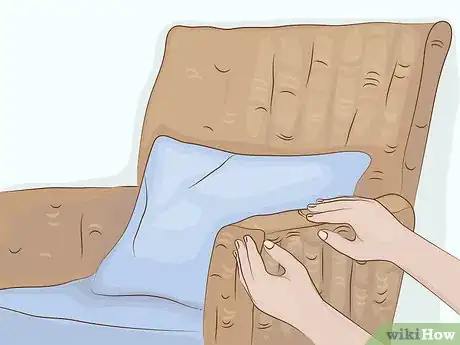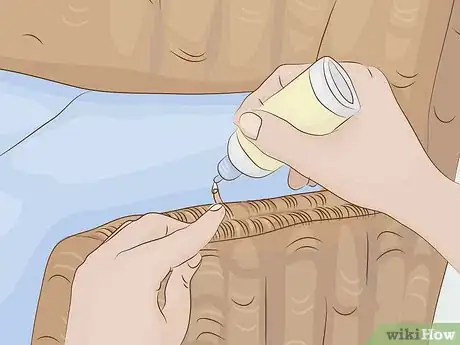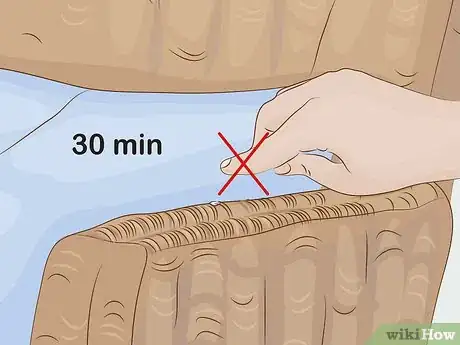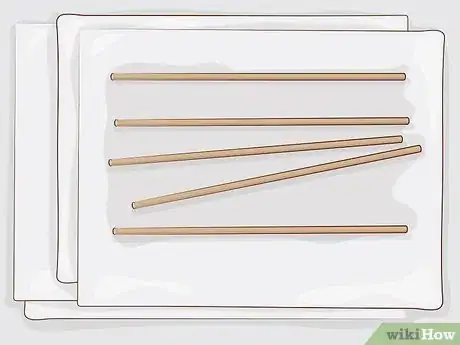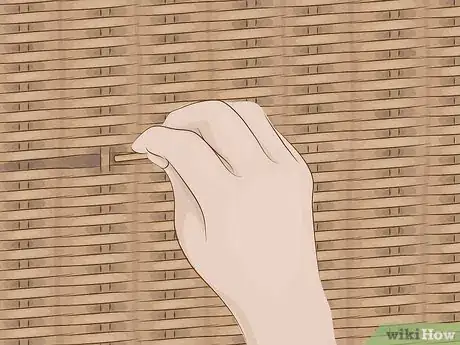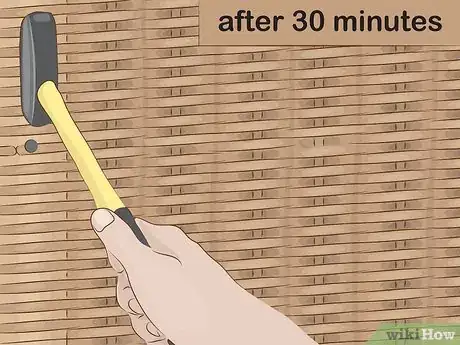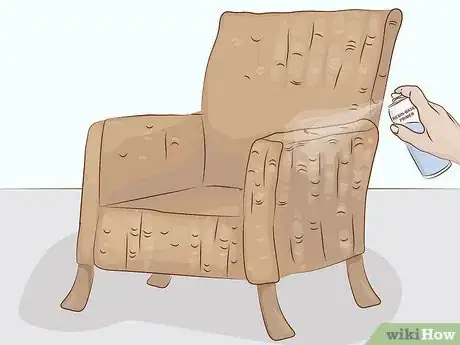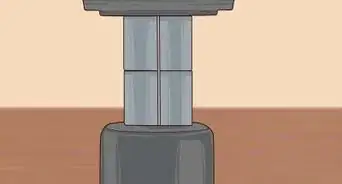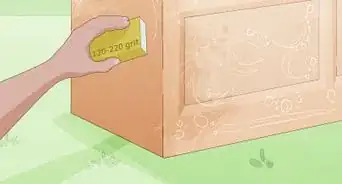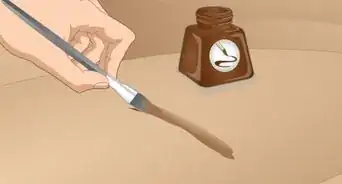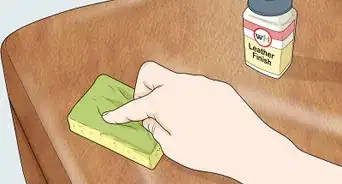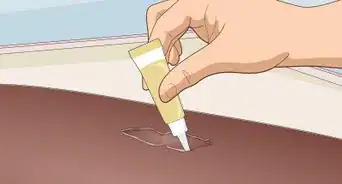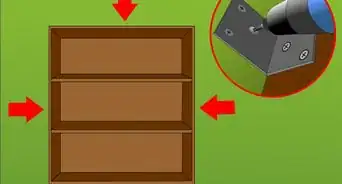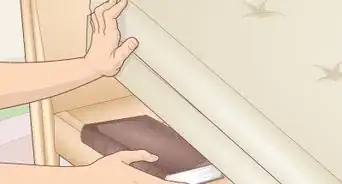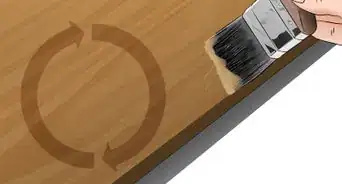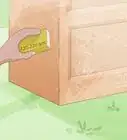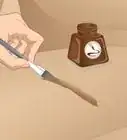This article was co-authored by Guy Peters. Guy Peters is the Owner of MOP STARS Cleaning Service, a complete house cleaning service for residential and commercial clients, based in Denver, Colorado. Founded in 2014, MOP STARS provides regular, move in/out, deep, and commercial cleaning services. Guy has a BA in Finance from the California State University - Sacramento and an MBA from Cornell University.
This article has been viewed 73,880 times.
Wicker furniture can be a lovely addition to your home if you are able to maintain it properly. It's easy to do basic repair, or you can use simple replacement reeds to do larger repairs! Your wicker furniture will stay in top shape if you clean it frequently and take good care of it.
Steps
Repairing Loose Ends
-
1Scan the furniture for loose ends. Examine your wicker furniture to spot any pieces poking out. Do this in a well-lit area, or use a map lamp or flashlight to see things clearly. Use your hands to feel for loose ends in place that you may not be able to examine easily close up. [1]
-
2Use wood glue to fix them. Apply a drop or 2 of wood glue to the bottom of any loose ends that are sticking out. Carefully tuck them back into the wicker pattern by pulling the strands together. Hold down the glued pieces for several seconds to allow them to bond to the chair. Do this for each loose strand you find.[2]Advertisement
-
3Let the glue dry for 30 minutes. Once you have tucked in and glued all the loose ends, allow the glue to dry. Avoid touching the furniture for a full 30 minutes so the adhesive can take hold. For the best results, leave the item of furniture in a cool, dry room during this time. [3]
Replacing Broken Reeds
-
1Remove broken strands of wicker. Use heavy-duty scissors or an exacto knife to cut loose strands out of your wicker furniture. Carefully snip through damaged strands near the underside of arms, legs, or other parts of the piece. gently pull out the damaged strands to avoid damaging other parts of the wicker.[4]
-
2Soak replacement reeds in warm water for 30 minutes to make them flexible. Select the replacement reeds you need to fix your damaged wicker furniture. Place them in a large container full of warm water. Let them sit in the water for 30 minutes.[5]
-
3Remove excess water from the reeds. Remove the reeds from the water and place them on a pile of clean paper towels. Gently press on the reeds with another paper towel to drain out excess water. Continue pressing on them with fresh paper towels until no more water comes out.[6]
-
4Weave the replacement reeds into the wicker furniture. Thread a replacement reed into the furniture, starting from a point near the back that is less visible. Using pliers or your fingers, gently weave the reed in an out of the wicker. Follow the pattern of the wicker for the best results.
-
5Glue the strands in place. Once the reed is all the way through, add a drop of wood glue to the ends. Tuck them in to keep them from sticking out. Gently hold the stands in place for several seconds to allow the glue to set.
-
6Secure the ends with carpet tacks after 30 minutes. Insert carpet tacks right on the ends of the replacement reeds once the wood glue is dry. Gently push the tacks in to avoid splitting the reed fibers. Use your finger or a small hammer to make sure the tack are securely firmly.[7]
Cleaning Wicker Furniture
-
1Clean the cushions. Wicker furniture that has cushions may be more prone to attracting odors, dust, and dirt. If possible, remove the cushioned parts of your furniture for cleaning. If they have removable covers, clean them in the washing machine and allow them to air dry. If they do not have removable covers, bring them to be professionally cleaned or use a wet vacuum to remove stains and odors.[8]
-
2Apply a cleaning solution of bleach and water to the surface of your wicker furniture. In a large bucket, mix 1 litre (4.2 c) of water and 250 millilitres (1.1 c) of household bleach. Use a clean cloth soaked in this solution to wipe down your wicker furniture. Allow it to air dry for 2-3 hours.[9]
- This solution will deodorize wicker and remove stains.
- Use gloves when applying this solution.
- You can also use a mixture of water and dish soap to clean your wicker furniture. Use a sponge or soft rag to apply the solution and avoid using anything too rough since most wicker can scratch easily.[10]
- If you're dealing with mildew, use a solution of 50% hydrogen peroxide and 50% water to remove it. This solution also reduces the chances of it coming back.
-
3Refinish the wicker by applying a primer for a clean finish. Place the wicker furniture outdoors or in a well-ventilated area. Spray a thin layer of resin-based primer over the entire surface of your wicker furniture. Let it dry for 2-3 hours.[11]
- Hold the can 2–3 inches (5.1–7.6 cm) away from the furniture when spraying it.
- Wear a mask to avoid inhaling fumes.
Things You'll Need
Repairing Loose Ends
- Wood glue
Replacing Broken Reeds
- heavy-duty scissors or an exacto knife
- Needle nose pliers
- A large container
- Replacement reeds
- Wood glue
- Carpet tacks
Cleaning Wicker Furniture
- 250 millilitres (1.1 c) household bleach
- A resin-based primer spray
- A mask
References
- ↑ http://www.nytimes.com/1988/08/28/nyregion/home-clinic-working-on-wicker.html
- ↑ http://www.nytimes.com/1988/08/28/nyregion/home-clinic-working-on-wicker.html
- ↑ http://www.nytimes.com/1988/08/28/nyregion/home-clinic-working-on-wicker.html
- ↑ http://www.nytimes.com/1988/08/28/nyregion/home-clinic-working-on-wicker.html
- ↑ https://homesteady.com/how-8016489-do-arms-resin-wicker-chairs.html
- ↑ https://homesteady.com/how-8016489-do-arms-resin-wicker-chairs.html
- ↑ http://articles.chicagotribune.com/1989-11-17/entertainment/8903100682_1_wicker-furniture-fibers-mildew
- ↑ http://articles.chicagotribune.com/1989-11-17/entertainment/8903100682_1_wicker-furniture-fibers-mildew
- ↑ http://articles.chicagotribune.com/1989-11-17/entertainment/8903100682_1_wicker-furniture-fibers-mildew
About This Article
Wicker furniture can get damaged over time, but you can easily repair it with some wood glue and loose reeds. If you have loose ends on your wicker furniture, first, apply a drop or 2 of wood glue to the bottom of the reeds. Then, carefully tuck the reeds back into the wicker pattern and hold them down for several seconds. Avoid touching the furniture for 30 minutes so the glue can fully dry. If you have a section on your wicker that’s broken, first, use an Exacto knife to cut out the damaged strands. Then, soak replacement reeds in warm water for 30 minutes to make them flexible. Drain the excess water, then weave the new reeds into the wicker pattern. Once they’re woven in, add a drop of wood glue to both ends to hold them in place. To learn how to clean your wicker furniture, read on!
